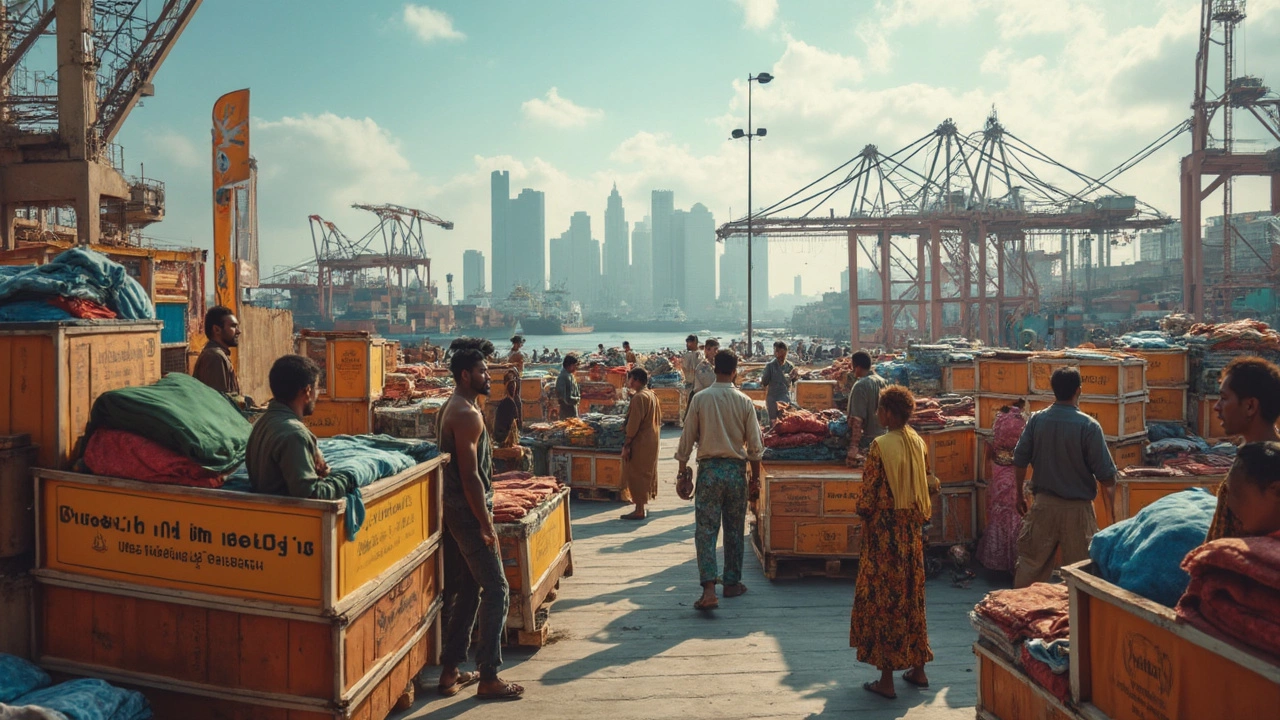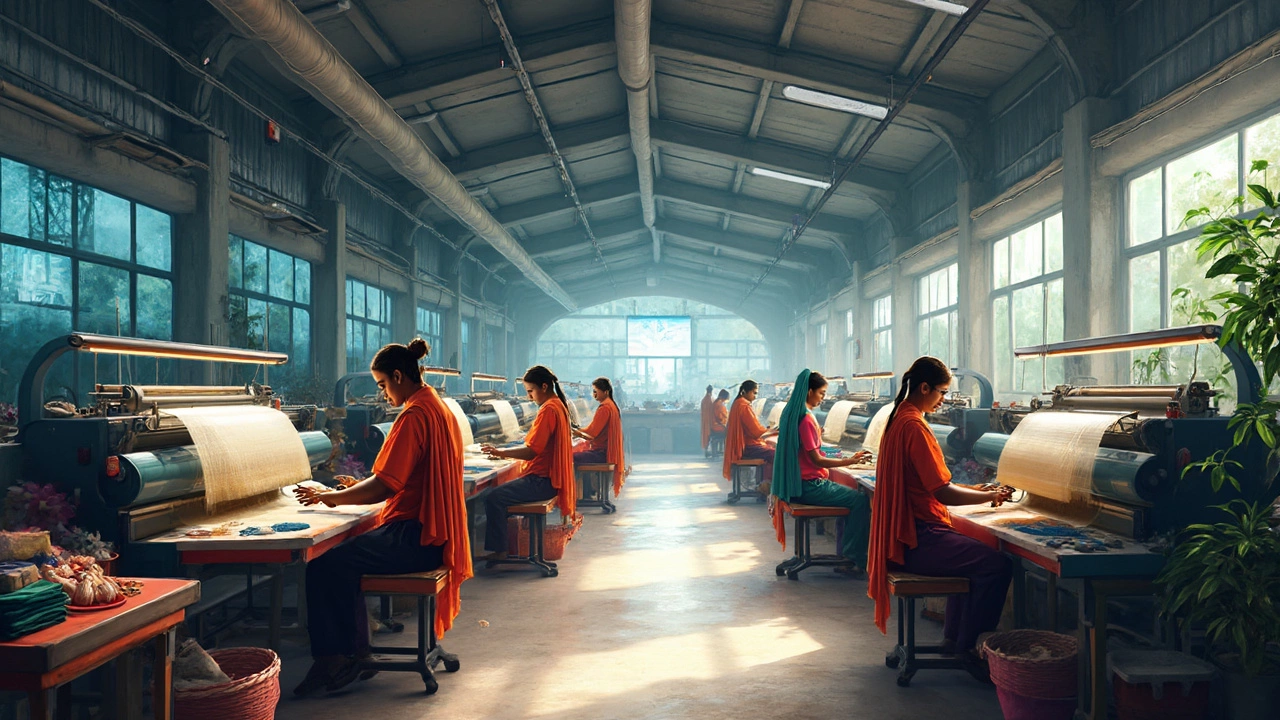The Indian textile industry in 2024 isn’t following its old playbook. This year, local demand is surging back up—old favorites like cotton and denim still sell, but demand for tech-friendly fabrics and recycled materials is hitting the big city stores. Buyers are less patient with long delivery times or quality hiccups. If you run or work with a textile manufacturer, you probably know there’s less room for error now than ever before.
Global demand is a roller coaster. Exports to the US and Europe are still making up a chunky piece of the pie, but political trade spats and currency swings can mess up margins overnight. Big chains want eco-labels and traceability, not just low prices. Meanwhile, costs keep creeping up—raw cotton prices, labor, freight—manufacturers have to budget tight or risk losing out.
- How 2024 Is Different for Textile Manufacturers
- Export Game: Wins, Woes, and New Routes
- Sustainability: Hype or Hard Rule?
- Technology and Innovation: Where the Smart Money Goes
- Practical Moves for Indian Textile Brands
How 2024 Is Different for Textile Manufacturers
This year, the changes aren’t just tweaks around the edges—things are shifting in core ways for Indian textile players. First off, consumer tastes are moving fast. People want breathable, easy-care fabrics, and brands are switching up their supply lists to match. Tech-driven textiles, like moisture-wicking sports gear and antimicrobial fabrics, are breaking into mainstream orders more than ever before.
One big fact: according to government figures, India’s textile and apparel market is expected to reach $250 billion by the end of 2024. Local demand is back up, driven by young shoppers who care about style and where their clothes come from. It’s not just Tier-1 cities either; sales are rising in smaller towns thanks to e-commerce and social media.
| Year | Domestic Market Size (USD Billion) | Export Value (USD Billion) |
|---|---|---|
| 2022 | 165 | 40 |
| 2023 | 180 | 44 |
| 2024 (Est.) | 195 | 49 |
Labor costs are climbing, and it’s hard to hire skilled workers who know modern machinery. This is making automation a bigger deal—even smaller textile units are buying auto-loom machines or setting up ERP tools just to stay in the race.
But it’s not just about tech and trends. Raw material costs, especially cotton, saw spikes of up to 20% after erratic rains hit key producing states like Maharashtra and Gujarat. This squeezes margins for textile manufacturers India wide open unless they lock in supplies early or blend with synthetics.
- Instant delivery expectations: Both brands and buyers want shorter turnarounds. The old six-month order lead just doesn’t work for most orders now.
- Source traceability: Big labels want digital proof of where every meter of fabric comes from.
- ESG rules: Factories face new checks on water use and worker safety, not just price negotiations.
Bottom line: what worked in 2021 or 2022 won’t cut it now. Manufacturers who adapt—by mixing new tech, smart sourcing, and understanding changing buyer moods—will actually make headway. Others might get pushed out, no matter how big they are.
Export Game: Wins, Woes, and New Routes
The export scene for Indian textiles keeps producers on their toes. In 2024, India's textile exports reached $45 billion by April, bouncing back 8% from last year, but that's still 12% shy of the pre-pandemic high. Top markets are the US, EU, and Bangladesh, with the US alone sucking up around 18% of our exports. The dream run isn't without hiccups. High shipping costs, new EU green taxes, and unpredictable demand from big retail buyers have made life tougher for manufacturers who’ve always relied on these markets.
Manufacturers are scrambling to adapt. The textile industry India knows the days of only shipping cheap bulk orders to the West are numbered. Middle Eastern and African buyers are stepping up their orders. For example, UAE and Saudi Arabia have hiked their imports by 15%+, and Egypt’s government has started sourcing school uniforms and bedsheets from Indian players. More companies are investing in certifications that work for Europe’s new Carbon Border Adjustment Mechanism (CBAM), to avoid delays or fines at customs.
The hottest products this year? Recycled polyester, stretch denim, and antimicrobial hospital fabrics. Exporters swear by quick shifts in product lines and aggressive pricing when freight rates spike. To stay competitive, smart players focus on:
- Shortening lead times by cutting down unnecessary production steps
- Going digital—using online platforms for B2B deals and documentation
- Certifying products early (like OEKO-TEX or GOTS) to keep the doors open with fussy buyers
Here's a quick look at recent export data by key destinations:
| Market | 2023 Exports (USD Billion) | 2024 Growth (%) |
|---|---|---|
| USA | 6.4 | +9 |
| EU | 7.1 | +3 |
| UAE | 2.2 | +19 |
| Bangladesh | 4.5 | +7 |
| Saudi Arabia | 1.1 | +16 |
If you’re in the game, don’t just watch what buyers want—study where the demand is trending. Those who adjusted their product mix early, especially toward sustainable and technical textiles, are staying on top of the pile.

Sustainability: Hype or Hard Rule?
Back in the day, "sustainability" was a buzzword that got tossed around but rarely moved the needle for Indian textile manufacturers. Fast-forward to 2024—it’s no longer optional, especially if you’re dealing with the big export markets. European buyers, for example, are straight-up refusing shipments without certifications like GOTS (Global Organic Textile Standard) or OEKOTEX. And it’s not just about the fabric anymore; they want safer dyes, eco-friendly packaging, and a clear story of how products are made.
The numbers make it clear: around 70% of Indian textile exports heading for the EU or US now require some sort of sustainability proof. The big names—Aditya Birla, Arvind Mills—are pouring cash into cleaner processes and better transparency. If you ignore the trend, you’ll risk losing major contracts. Some brands share that a lack of "green creds" cost them repeat orders in 2023 and Q1 2024.
The cost of going green isn’t cheap, but smart manufacturers are finding ways to balance it out:
- Switching to recycled polyester or organic cotton trims production waste and wins brownie points with clients.
- Installing water recycling units drops chemical discharge. In fact, some textile units near Tirupur cut water usage by up to 60% just by recycling.
- Investing in quality certifications saves time on due diligence and often lands better rates from big buyers.
Check out how things are stacking up:
| Year | % Exports Requiring Sustainability Proof | Major Certification Types |
|---|---|---|
| 2021 | 40% | GOTS, OEKOTEX |
| 2023 | 60% | GOTS, OEKOTEX, BCI, Fairtrade |
| 2024 | ~70% | GOTS, OEKOTEX, ZDHC, Higg Index |
So, for India’s textile industry, sustainability is now baked into the business. If you’re not already tracking your supply chain or upping your eco standards, now’s the time to get on it or risk losing out—plain and simple.
Technology and Innovation: Where the Smart Money Goes
If you walk through a modern textile manufacturing unit in India today, it’s hard to ignore all the tech upgrades buzzing in the background. Automation isn’t just a big word thrown around at trade shows—it’s already changing the daily grind. Automatic loom and dyeing machines are showing up everywhere, cutting down human error and boosting speed. In some Surat mills, tech-driven workflow has slashed production times by 30%. That’s not a small win.
Digital printing is making its mark. Now, manufacturers can handle smaller batches without wasting truckloads of fabric or color, opening the door to custom orders for brands that hate old-school minimums. Plus, with cloud-based stock tracking, you don’t have to sweat about over-ordering raw materials or losing track of finished stock.
Sustainability isn’t just about recycled cotton—waterless dyeing tech is gaining ground, with Indian companies snagging international deals thanks to lower water use. RFID tracking chips are starting to pop up more and more, so big buyers can follow the journey of their order, from raw fiber to finished T-shirt. The younger workforce is also driving demand for tech gigs over traditional mill jobs.
Just check out some numbers on tech adoption and results in Indian textile units:
| Technology | Adoption Rate in 2024 (%) | Reported Benefit |
|---|---|---|
| Automation & Robotics | 38 | Lower error rates, 25–30% faster output |
| Digital Textile Printing | 45 | Shorter lead times, less waste |
| Waterless Dyeing | 12 | Over 60% water savings |
| RFID Inventory Tracking | 20 | Real-time traceability |
The takeaway? Smart manufacturers are pushing their textile industry India presence with tech. If you’re not already looking at at least one of these options, you’re probably losing ground to someone who is.
- Start small with affordable automation—think sewing bots or simple barcode tracking.
- Tap into government subsidies meant for tech upgrades—these schemes actually exist if you dig a little.
- If you export, invest in digital tools for LC (Letter of Credit) and documentation—they speed up payments and smooth out compliance headaches.
Sure, there’s some upfront cost. But with margins tighter than ever, clinging to old tools just isn’t a great way to win in 2024.

Practical Moves for Indian Textile Brands
Staying competitive in the textile industry India scene in 2024 calls for more than just churning out fabric. It’s about making smart, simple changes that match what buyers want and what the market needs.
First, brands should get serious about supply chain speed and reliability. Late deliveries are getting costlier because buyers have more options now. Top manufacturers are digitizing their order tracking systems and using better ERP tools to spot delays before they snowball. If your operation still runs on endless paperwork, it’s time for an upgrade.
Sustainability is no longer optional. The biggest brands—think H&M, Decathlon, even big domestic retailers—are demanding real proof of sustainable sourcing. Certifications like GOTS (for organic textiles) or OEKOTEX are now requirements on big export deals. If you're planning to enter new markets or scale exports, start your compliance work now; audits can take months and customers don’t want to wait.
Cost control is another area brands can’t ignore. Raw cotton prices were up almost 20% through 2023 and haven’t dropped much in 2024. Smart textile manufacturers are branching into blended yarns or recycled fiber to reduce costs without lowering quality. A single shift to recycled cotton or polyester can open up business with brands that prize circular fashion.
There's also power in leaning on India's traditional strengths. Jacquard weaving, handloom work, and natural dye processes stand out in global markets flooded with synthetic fast fashion. Adding a heritage collection or limited-run artisanal products can catch the eye of international buyers hunting for something unique.
Finally, do not underestimate direct-to-customer (D2C) sales. Even smaller, lesser-known textile businesses are launching Instagram shops or selling through Amazon India and Flipkart. These platforms help cut middlemen and grow brand recognition overnight. Just make sure you keep product stories real—today’s buyers spot marketing fluff a mile away.
Bottom line: those who focus on process upgrades, clear sustainability, tighter costs, and smart branding will be better placed as the industry keeps shifting. The old formula of cheap labor and volume isn’t enough anymore. It’s all about agility, trust, and transparency in 2024.

